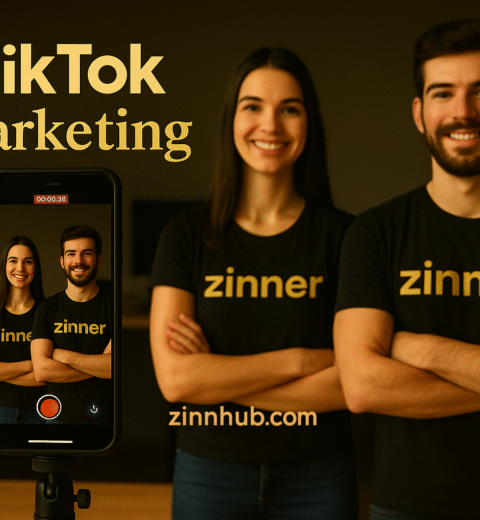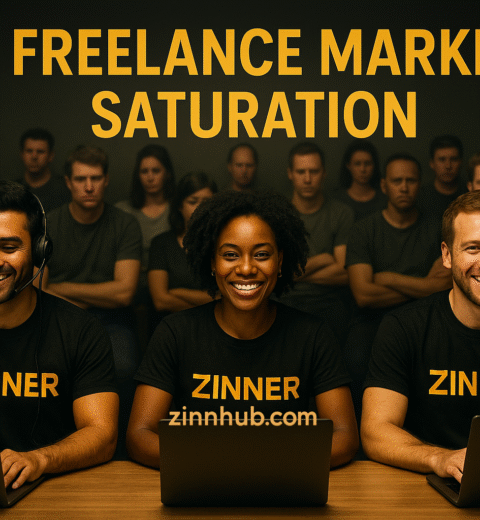Table of Contents
- Why Instagram Marketing Matters More Than Ever
- Understanding the Instagram Algorithm (And Why It Hates You?)
- Content Types That Actually Convert
- Building a Community, Not Just a Following
- The Art of the Instagram Caption
- Hashtag Strategy That Actually Works
- Instagram Shopping: Turning Browsers into Buyers
- Going Live: Real-Time Connection That Converts
- Measuring Success Beyond the Likes
- Collaborations and Influencer Partnerships
- Affiliate Marketing on Instagram
- Common Instagram Marketing Mistakes to Avoid
- Automation Tools That Save Your Sanity
- Instagram as Customer Service Channel
- The Future of Instagram Marketing
- Your Next Steps
Instagram marketing has become the digital equivalent of having a shop window on the world’s busiest high street, where over 2 billion people stroll by every month looking for inspiration, entertainment, and yes—products to buy. I’ve spent the last five years helping brands crack the Instagram code, and honestly? It’s both easier and harder than most people think. Whether you’re flogging handmade soaps from your kitchen table or running a multi-million-pound operation, Instagram’s weird blend of pretty pictures and algorithm roulette can either make you or leave you shouting at your phone at 3 AM.
Instagram—it’s where avocado toast became a superstar, cats earned influencer status, and your grandma learnt what a hashtag actually does. But beyond food snaps and feline influencers, Instagram is an unparalleled marketing powerhouse, offering endless possibilities to connect with a global audience. So, how do you harness the magic of Instagram marketing?
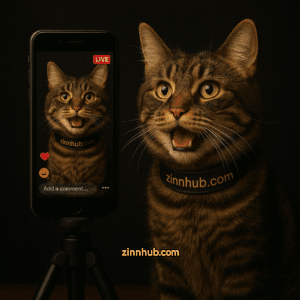
Why Instagram Marketing Matters More Than Ever
Right, here’s the thing: if your business isn’t on Instagram in 2025, you’re essentially turning down free invitations to the world’s largest networking event. I know that sounds dramatic, but stick with me. The platform’s gone way beyond those Valencia-filtered brunch photos we all posted in 2012 (remember those? Dark times).
These days, it’s basically a shopping centre, TV channel, and community hub rolled into one slightly addictive app. And the numbers? Mental. We’re talking 90% of Instagram users following at least one business account. That’s not a typo. Nine out of ten people are actively choosing to see business content in their feeds.
Even better—83% of users say they discover new products on Instagram. That’s higher than any other platform, including the actual shops on the high street. Your competitors? They’re already there, sliding into your customers’ DMs with their perfectly curated grids and witty captions. Sorry to be the bearer of bad news.
Why Instagram Marketing Matters in 2025?
Understanding the Instagram Algorithm (And Why It Hates You?)
The Instagram algorithm. Those three words have probably caused more marketing meltdowns than any others in history. It’s like that mate who swears they’re “easy-going about food” and then rejects seventeen restaurant suggestions. But once you understand what makes it tick, you can actually work with it instead of against it.
At its core (and despite what conspiracy theorists on Twitter claim), the algorithm cares about three main things: relationship, interest, and timeliness. Not reach, not follower count, not how much you spent on that iPhone 15 Pro. Just those three.
Relationship is exactly what it sounds like. The algorithm’s basically playing favourites, showing users content from accounts they actually engage with. Here’s a proper example: Nicole, who runs a bakery in Brighton, comments on every one of your posts and shares your stories with her mates. Instagram clocks this and thinks, “These two are besties; better make sure Nicole sees everything from this brand.” Meanwhile, that follower who hit follow three years ago and never looked at your content again? They probably haven’t seen your posts since 2022.
Interest works like your Netflix recommendations but less creepy (arguably). If someone’s watched 47 cooking reels in a row, Instagram’s not going to suddenly start showing them cryptocurrency content. This is why niching down isn’t just marketing waffle—it actually helps the algorithm understand who should see your stuff.
Timeliness still matters, despite what Instagram claims about not being chronological. Fresh content gets a boost, but—and this is crucial—that doesn’t mean posting every bloody hour. I tried that once. Nearly lost my mind and definitely lost followers.
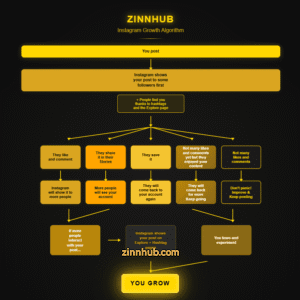
Content Types That Actually Convert
Remember when we all thought Instagram was just for square photos with heavy filters? Those were simpler times. Now we’ve got more content types than a Wagamama menu, and each one serves a different purpose in your marketing mix.
Reels are Instagram’s golden child right now, and the algorithm isn’t even trying to hide it. These short videos (up to 90 seconds, though let’s be honest, most of us lose interest after 30) get 22% more engagement than regular videos. But here’s what nobody tells you—Reels only work if they don’t feel like ads. I’ve seen brands spend thousands on polished Reels that get outperformed by someone filming their cat with a potato-quality camera. The secret? Entertainment first, selling second. Use trending audio, but make it make sense for your brand. Nothing worse than a law firm doing the latest dance trend. Actually, I take that back—I’d probably watch that.
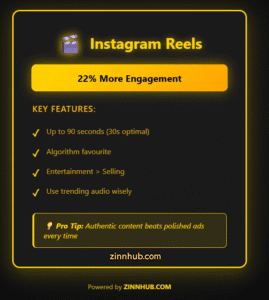
Carousel posts are the dark horse of Instagram content. You know, those swipeable posts that make you feel like you’re reading the world’s shortest magazine? They’re absolutely brilliant for keeping people on your content longer, which sends all the right signals to our algorithmic overlord. I use them for before-and-afters, mini tutorials, and those “swipe to see the disaster” posts that everyone secretly loves. Pro tip: Put your best image second or third. A bit weird, but it increases swipes.
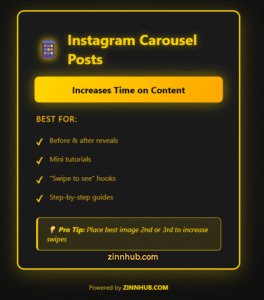
Stories disappear faster than my motivation on a Monday morning, but they’re gold for building real connections. With polls, questions, quizzes, and about seventeen other stickers, Stories let you have actual conversations with your audience. They’re perfect for the messy middle—the behind-the-scenes content that’s not polished enough for your grid but too good to waste.
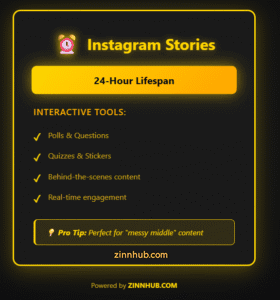
Right, quick sidebar about Story Highlights. You know those little circles under people’s bios? Those are your always-open shop windows. I’ve seen brands use them brilliantly—FAQs, size guides, customer reviews, even mini catalogues. One fashion brand I work with gets 40% of their website traffic from a “Sale Items” highlight. Forty percent! From a single circle!
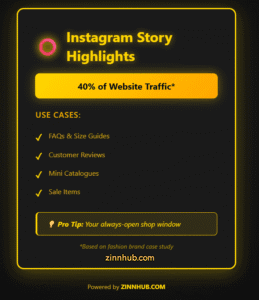
Static posts aren’t dead, despite what the social media gurus claim. They’ve just evolved. A stunning product shot or thoughtful quote still works, but only if it tells a story. The days of posting a product on a white background with “Now available!” are gone. Thank goodness.
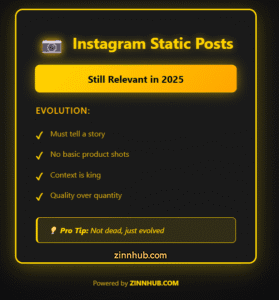
Building a Community, Not Just a Following
Can we talk about vanity metrics for a second? I know someone with 127K followers who gets less engagement than my local coffee shop with 2,000. Having loads of followers is like having a massive party where everyone’s on their phones ignoring each other. Pointless.
What you want is a community. People who actually care about what you’re doing. And building that starts with the unglamorous work of actually talking to people. Mad concept, I know.
Respond to comments. Not with just emojis (though they have their place), but with actual words. When someone takes time out of their doomscrolling to comment on your post, ignoring them is like blanking someone who waves at you on the street. Rude and bad for business.
But here’s where most brands get it wrong—they wait for people to come to them. Nah. Go comment on your followers’ posts. Like their content. Share their Stories when they tag you. One brand I know grew from 5K to 50K followers in a year just by being genuinely interested in their community. No ads, no influencers, just good old-fashioned giving a damn.
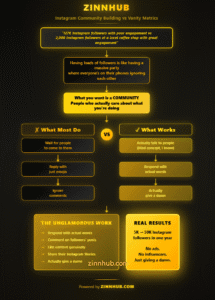
The Art of the Instagram Caption
Captions are where you can really let your brand personality shine. Or completely balls it up. I’ve seen both happen, often from the same brand in the same week.
Those first 125 characters before the “more” button? That’s prime real estate. That’s Mayfair on the Monopoly board. Don’t waste it on “Happy Monday!” or “Check out our new…” BORING. Start with something that makes people stop scrolling. A question, a controversial opinion, the beginning of a story they need to finish.
Instead of “New winter collection now available,” try “That jumper your ex stole and never gave back? We’ve made a better one.” See? Now I want to know more about this superior jumper.
And please, for the love of all that is holy, stop ending every caption with “Link in bio.” We know where the link is. We’re not idiots. Try “Sarah wore this three ways—swipe to see her least favourite” or “Warning: may cause unprecedented levels of comfort.” Make it conversational. Make it human.
Hashtag Strategy That Actually Works
Hashtags. Still using them like it’s 2018? #Stop #It #Now #Please #This #Isn’t #Working.
The Instagram hashtag game has changed massively, and most people haven’t noticed. You don’t need 30 hashtags anymore. In fact, using 30 makes you look desperate. It’s like wearing all your jewellery at once—technically possible, but why?
5-10 hashtags. That’s the sweet spot. Mix it up with popular ones (over 1M posts), medium ones (100K-1M), and niche ones (under 100K). Think of it as fishing with different-sized nets. The big hashtags might get you views, but the small ones get you customers.
And create a branded hashtag, but make it something people will actually remember and use. #BestBrandEver2024Official is not it. One sustainable fashion brand I know could use #WornWellLoved and their customers would post photos years after purchase showing how their clothes have aged. Genius.
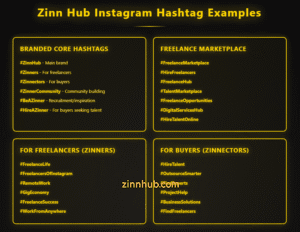
Instagram Shopping: Turning Browsers into Buyers
Instagram Shopping has turned the platform into the world’s most addictive shopping centre. The journey from “Oh, that’s nice” to “Where’s my credit card?” has never been shorter. Three taps. That’s all it takes now. Dangerous for my bank account, brilliant for your business.
If you’re a smaller brand feeling intimidated by all the features, here’s a secret: start dead simple. Tag products in your posts. Add a shopping sticker to your Stories. That’s it. You don’t need a massive catalogue or fancy setup. I’ve seen brands with five products outsell ones with five hundred because they made those five products irresistible.
But please, PLEASE, set it up properly. Clear descriptions, multiple photos (including someone actually using/wearing/eating the product), and accurate pricing. I once saw a brand with “price on request” for a £15 t-shirt. What are you, a luxury yacht dealer?
Those Shopping stickers in Stories? Use them sparingly but strategically. “Only 3 left” actually works if it’s true. But if you cry wolf with fake scarcity, people remember. The internet never forgets.
Going Live: Real-Time Connection That Converts
Instagram Live used to terrify me. The thought of broadcasting live to hundreds of people with no edit button? Nightmare fuel. Then I discovered something mad—people actually prefer the unpolished reality.
Lives create this weird urgency that nothing else on the platform can match. FOMO on steroids. One luxury handbag designer I follow does weekly drops exclusively through Live. We’re talking £2,000 bags selling out in under three minutes. She calls it “Hunger Games for handbags,” and honestly? Accurate. She’s pulling in £55K per session. From her living room. On her phone.
The thing is, people can smell fake from a mile away. Your followers don’t want a QVC presenter; they want YOU. Stumble over your words? Leave it in. Cat jumps on your lap mid-pitch? Content gold. I once watched a pottery brand’s Live where everything went wrong—the wheel jammed, clay went everywhere, the potter swore on camera. Best engagement they’d ever had.
You don’t need fancy equipment. Good lighting (window light works), decent audio (earbuds are fine), and something interesting to say. Start with 10-minute Q&As if you’re nervous. Schedule them same time each week so people know when to tune in. And save the good bits as Reels afterwards—double the content, half the work.
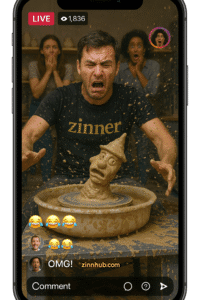
Measuring Success Beyond the Likes
Instagram experimenting with hiding likes taught us something valuable. Controversial opinion? Maybe. But it forced us to look at metrics that actually matter.
Engagement rate is your real MVP. Take your likes, comments, saves, and shares, divide by followers, and multiply by 100. If you’re hitting 1-3%, you’re doing alright. Above 3%? You’re smashing it. Below 1%? Time to reassess whether you’re talking to the right people.
Reach and impressions tell you if the algorithm likes you. If your reach is consistently less than 10% of your followers, something’s off. Either your content’s not resonating, or you’re posting when everyone’s asleep.
Website clicks and conversions—this is where the rubber meets the road. Use UTM parameters (code you add to your links that tell you exactly where your website traffic came from) to track which posts actually drive sales. That viral Reel might’ve gotten a million views, but did it sell anything? Sometimes the boring product post outperforms the entertainment content for actual revenue.
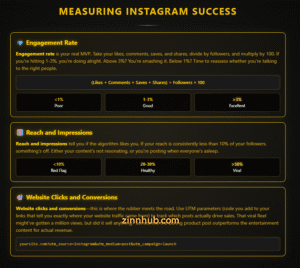
Collaborations and Influencer Partnerships
Influencer marketing gets a bad rap because of those cringey #ad posts where someone who’s never used your product pretends it changed their life. We’ve all seen them. We all hate them.
But done right? Magic happens. Forget the celebrities and mega-influencers unless you’ve got Coca-Cola’s budget. Micro-influencers (1K-100K followers) are where it’s at. Their audiences actually trust them. Revolutionary concept—working with people whose followers genuinely care about their opinions.
Find influencers who’d use your product anyway. A fitness brand working with someone who actually goes to the gym. A cooking brand partnering with someone who doesn’t just order Deliveroo seven nights a week. The enthusiasm shows.
And please, give them creative freedom. Nothing kills authenticity faster than a script. Brief them on key points, sure, but let them talk about your product in their voice. Their audience follows them for a reason.
Affiliate Marketing on Instagram
Speaking of partnerships, affiliate marketing’s having a moment. It’s like influencer marketing’s more accountable cousin—people only get paid when they actually drive sales. Win-win, assuming you set it up right.
Common Instagram Marketing Mistakes to Avoid
Buying followers is like stuffing your bra—it looks impressive until someone gets close enough to realise it’s all padding. Plus, 10K ghost followers actually hurts your engagement rate. The algorithm’s not stupid.
Ignoring new features when Instagram launches them is like refusing free samples at Costco. When Stories launched, early adopters got massive reach. Same with Reels. Same with Shopping. Be an early adopter, even if you feel like your dad trying to use TikTok.
Posting without a strategy wastes everyone’s time. Pick 3-5 content pillars (themes you’ll regularly post about) and stick to them. Random content confuses your audience and the algorithm.
Neglecting your bio is criminal. 150 characters to tell people who you are, what you do, and why they should care. Don’t waste it on inspirational quotes unless you’re literally a motivational speaker.
Automation Tools That Save Your Sanity
Managing Instagram alongside actually running a business feels like juggling chainsaws while riding a unicycle. Backwards. On fire. This is where the right tools become your best mate.
But first, a warning: those tools that promise to auto-like 1000 posts a day? Bin them. Instagram can smell automation from space, and they’ll shadowban you faster than you can say “organic reach.” I learnt this the hard way in 2019. Dark times.
What you CAN automate: scheduling posts (Later, Buffer, and Hootsuite all work brilliantly), analytics tracking (saves manually counting everything like some sort of social media accountant), and content creation templates (Canva’s saved my bacon more times than I can count).
The trick is using automation to handle the boring bits so you can focus on the human bits. Schedule your posts, sure, but respond to comments yourself. Use templates for consistency, but write captions fresh. Think of automation as your assistant, not your replacement.
Instagram as Customer Service Channel
Nobody talks about this, but the second you start succeeding on Instagram, your DMs become customer service central. That notification sound will haunt your dreams.
Instead of panicking, embrace it. Quick responses to public comments show potential customers you’re not one of those brands that posts and ghosts. Set up quick replies for the questions you get seventeen times a day (sizing, shipping, or “Is this vegan?”).
Create Story Highlights that answer common questions before people need to ask. Size guides, shipping info, care instructions, and your return policy (please have one). It’s like hiring a customer service rep who never sleeps and never gets sarky with difficult customers.
But here’s the real secret: your grumpiest customer can become your biggest advocate if you handle their complaint well. I’ve seen brands turn one-star situations into five-star relationships just by responding quickly and actually caring.
The Future of Instagram Marketing
Instagram keeps evolving faster than fashion trends. AR filters are getting mental (in a good way), AI shopping recommendations are scarily accurate, and don’t get me started on whatever Meta’s cooking up in their labs.
But here’s what won’t change: people want connection. They want to buy from brands that get them, make them laugh, solve their problems, or just make their lives a bit better. All the fancy features in the world won’t help if you’re boring.
The brands killing it in five years will be the ones who adapted to new features while keeping their humanity. It’s not about being perfect. Perfect’s boring. It’s about being real, being helpful, and occasionally being weird enough to stand out.
Your Next Steps
Look, I could waffle on about Instagram strategy until the cows come home (and frequently do after a few wines), but nothing beats actually doing it. Start where you are with what you’ve got.
Pick ONE thing from this guide to try this week. Just one. Maybe it’s your first Reel, maybe it’s actually responding to comments with more than “Thanks! 💕”, or maybe it’s finally setting up Shopping. Whatever it is, just start.
Instagram marketing’s not a sprint; it’s a marathon where the route keeps changing and occasionally you’re running backwards. Some posts will absolutely tank. I once spent three hours on a Reel that got 47 views. Forty. Seven. But the next one? 50K and counting.
The secret nobody tells you? We’re all winging it. Even the brands with millions of followers and fancy strategies. The difference between success and failure isn’t perfection—it’s showing up consistently, learning from what works, and remembering that behind every username is an actual human being looking for something interesting.
So go on and post that slightly imperfect photo. Write that caption that makes you snort-laugh. Try that feature you’ve been avoiding. Your future customers are scrolling right now, waiting for something—someone—real to connect with.
That someone might as well be you.



